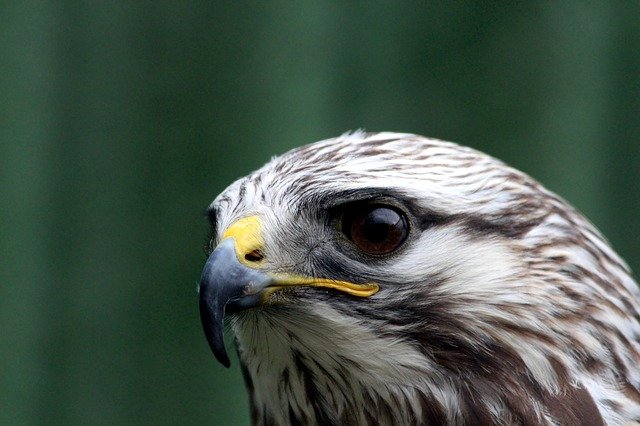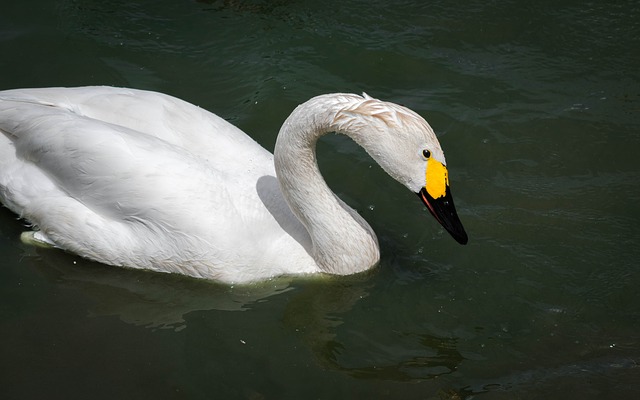Ohio has a number of large avian inhabitants, all unique in their own right. In this article I’ll be going over 7 unique big birds you can spot throughout the state. Continue reading if you want to learn a bit more about what these big birds and where you’d be able to spot them.
- Great Horned Owls
- Bald Eagle
- Rough Legged Buzzard
- Tundra Swan
- Wild Turkey
- Canada Goose
- Northern Goshawk
7 Big Birds In Ohio
1. Great Horned Owl (Bubo Vrginianus)

- Size: 57 – 63cm
- Weight: 1.4 – 15kg
- Wingspan: 1.35 – 1.5m
Great horned owls can be spotted in Ohio all throughout the year.
These large horned owls are recognised by their brown/gray plumage with their defining feature being the tuft of feather on the top of their head resembling a horn or ear like feature. Male and female great horned owls look relatively the same with the females slightly larger in size.
At night these birds will perch on a branch or a tall building to look around for prey and once the desired prey has been found they will fly towards it with folded wings, grab the prey with their talons piercing through their body and in most cases killing them immediatley.
As for what these birds eat it includes smaller prey like rodents, frogs or scorpions. Even other larger predators like geese, ducks, hawks, and smaller owls can be eaten by these carnivorous birds.
Great horned owls are most commonly found in deserts, wetlands, forests, grasslands, backyards, cities and they can also be found in semi-open habitats between the Arctic and the tropics.
As for a great horned owls lifespan, it can be anywhere from 15 -25 years.
2. Bald Eagle (Haliaeetus Leucocephalus)

- Size: 90 – 108cm
- Weight: 3 – 6.3kg
- Wingspan: 180 – 250cm
Blad eagles can be found in Texas throughout there non-breeding months, which will normally include the late fall and winter months.
A bald eagle’s plumage consists of dark brown around its wing and body, with white feathers on its tail and head along with the trademark yellow beak and feet. Both male and female bald eagles look relatively the same.
As for where you can find these eagles, it will often be around lakes and reservoirs with lots of fish and surrounding forests. You’ll often find them around unfrozen lakes and hunting along coastlines, reservoirs, and rivers during the winter months
These eagles are birds of prey meaning they hunt other birds, medium sized mammals like rabbits, hares, other animals like reptiles, fish and even eat carrion when their options are limited. Sometimes bald eagles are recognised as fish eagles as their diet consists of fish and as meat is the only thing they eat these eagles would ultimately be regarded as carnivores too.
Blad eagles can live for around 20 years in the wild.
3. Rough Legged Buzzard (Buteo lagopus)

- Size: 46 – 59cm
- Weight: 0.6 – 1.3kg
- Wingspan: 120 – 150cm
Rough legged buzzards can be found in Ohio throughout the winter, non-breeding months.
These buzzards are recognised by their brown and white plumage where their wings are brown, their neck and head black and the underside of their belly and wings with elements of brown but, mostly white in color. Females are generally just the larger of the 2.
You’ll often find rough legged buzzards around bogs and mountainous heathland areas, or in clearings in coniferous woodlands.
As for what these buzzards eat, it includes birds, reptiles, amphibians, larger insects among other smaller rodents and mammals.
These hawks can live for around 19 years in the wild.
4. Tundra Swan (Cygnus Columbianus)

- Size: 120 – 147cm
- Weight: 3.8 – 10.5kg
- Wingspan: 160 – 175cm
Tundra swans can only be found in Ohio when they tend to make their migratoty passage through the state.
These swans are recognised by their entirely white plumage, with black and yellow beaks. Male and female tundras look the same but, the bills of males will swell up in breeding season unlike the females.
You’ll often find these swans around near the coast. During migration and through the winter, they inhabit shallow lakes, slow-moving rivers, flooded fields, and coastal estuaries.
As tundra swans are herbivores, they will primarily eat roots, stems and leaves of aquatic vegetation, such as mannagrass, pondweeds, and even algae.
The average lifespan for these birds is around 10 years although this lower number is due to the various diseases these swans to suffer from. If a tundra swan is in good health throughout their lives, staying alive for 20 – 24 years isn’t too far off from what’s possible.
5. Wild Turkey (Meleagris Gallopavo)

- Size: 76 – 120cm
- Weight: 2.5 – 11 kg
- Wingspan: 120 – 140cm
Wild turkeys can be found in the majorty of Ohio year round although it will be far harder to find them around the north eastern region of the state.
These turkeys are recognsied by their black body with a featherless and pink neck, their tail feathers that fan out like that of a peacock. Females are significantly smaller in size than the males whilst they also don’t have tail feathers that fan out.
You’ll often spot a wild turkey around woodlands that are near water, swamps and grasslands.
As for what they eat, it includes the likes of seeds, insects, and an occasional frog or lizard.
Wild turkeys are known to live for only around 3 – 5 years even though these birds are on the bigger side.
6. Canada Goose (Branta Canadensis)

- Size: 75 – 110cm
- Weight: 2.5 – 6.5 kg
- Wingspan: 130 – 180cm
You’ll be able to spot these gesse in Ohio year round as it’s a permenant residence of theirs.
Canada geese are recognised by their white, gray and black plumage, where their breast, underside of the tail and side of the head are white, their back and belly gray in color, with a large portion of their neck, head and tail feathers black in color. Male and female Canadian gesse are relatively the same in appearance
Canada goose are mostly commonly spotted in and around lakes, ponds, bays, marshes or fields.
These geese are known to eat a variety of food sources such as stems and shoots of grasses, sedges, aquatic plants, cultivated seeds, berries, insects, mollusks, crustaceans, as well as the occasional small fish.
As for their lifespan, these Canadian geese can live for around 10 -24 years.
7. Northern Goshawk (Accipiter Gentilis)

- Size: 55 – 61cm
- Weight: 0.63 – 1.4kg
- Wingspan: 105 – 115cm
Northern goshawks can be found in the eastern part of the state throughout their non-breeding season. This will generally be around the winter and later fall months.
These hawks are recognised by their moslty gray and white plumage with a horizontal zebra like gray pattern across their belly and breasts. The females are generally more brown in color and are also bigger in size.
You’ll often spot northern goshawks around deciduous and coniferous forests.
They’ll generally feed on smalller rodents, mammals and birds like snowshoe hares, rabbit, gray and red squirrels, chipmunks, weasels, ducks, grouse, quail, pheasants, crows, small hawks, owls, woodpeckers, blackbirds, blue jays, grasshoppers, as well as insects like moth and beetle larvae.
Northern goshawks are known to live for around 7 years on average in the wild, with the longest living ones achieving a lifespan of around 19 years.
Amhil Khan, a dedicated nature enthusiast and the founder of BirdsOfTheWild.com, is a passionate advocate for the captivating world of avian wonders. With a deep-seated curiosity about the intricate lives of birds, Amhil’s journey began as a fascination and has evolved into a mission to inspire others to appreciate and protect these magnificent creatures.
Amhil’s love for birds led to the creation of Birds of the Wild, a platform where his expertise in ornithology, coupled with his captivating storytelling, provides readers with an immersive and educational experience. Through his lens and words, he captures the essence of birds in their natural habitats, offering a glimpse into their behaviors, migrations, and the ecosystems they inhabit.

